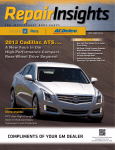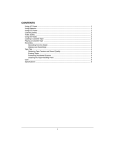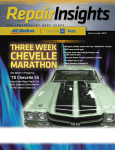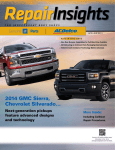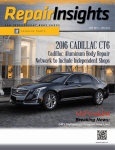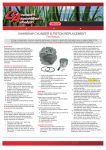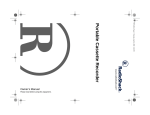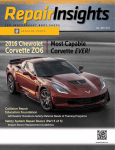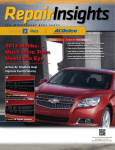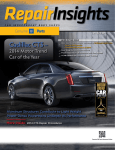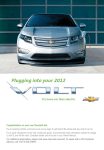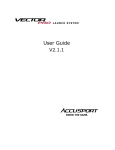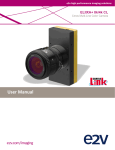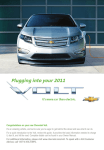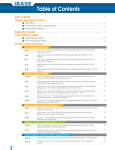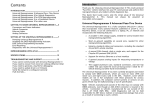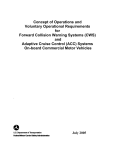Download July/September 2010 - GM Repair Insights
Transcript
RepairInsights F O R I N D E P E N D E N T B O D Y S H O P S July–Sept 2010 > More Genuine GM Parts Fast-Cash > GM offers new A/C Compressor choices: servicing tips > Emphasis on safety: Hybrid vehicle training for Independent Body Shops > SCRS documents position on SRS > GM at NACE 2010 > New HiPer Strut Suspension introduced > Countdown to Volt continues > Shops value OEM for their customer’s sake New ’Vette’s Launch Control feature optimizes traction for greater and more consistent on-track performance. Details on page 7. CONTENTS GM Parts Product Update 4 The Technical Side The latest word on product development and technologies. 7 Discover new ways to approach service and repairs. Repair Industry News & Updates 5 Business of Repairs Get state-of-theindustry perspectives from GM insiders. 10 New ideas that can benefit how your shop operates and profits. GM RepairInsights Online More Genuine GM Parts resources and links. Download this issue and past issues of GM RepairInsights magazine at... www.gmrepairinsights.com GM RepairInsights Headquarters 2604 N.E. Industrial Dr., #230 N. Kansas City, MO 64117 E-mail: [email protected] Compliments of your GM dealer. We invite your input and suggestions. Please address letters to the editor to the above address. Letters submitted imply the right to edit and publish. Every effort is made to ensure the accuracy of the information in the offers contained in this magazine. However, printing and typographical errors may occur. These are not intentional and are not the responsibility of GM, any GM dealer, or the companies or individuals who create, produce and distribute this magazine. Offers and pricing may change at any time without prior notification. The descriptions and specifications in this publication were in effect at the time of approval for printing. General Motors reserves the right to change specifications without notice and without obligation. Published letters do not necessarily reflect the opinions of General Motors, General Motors Parts, General Motors LLC, Detroit, MI 48202. 2010 General Motors LLC. All rights reserved. NEW FAST-CASH REBATES Convert aftermarket parts to Genuine GM Parts and earn unlimited rebates. Get started today . . . this program is for qualifying collision parts purchases from July 1 to December 31, 2010! $20 Earn VISA® Gift Card Rebates and provide your customers peace of mind when you choose Genuine GM Parts. Fast-Cash VISA® Gift Card Rebate > HOODS $15 Fast-Cash VISA® Gift Card Rebate > FASCIAS > ENERGY ABSORBERS > BUMPERS > BUMPER REINFORCEMENT > HEADLAMP ASSEMBLIES BARS > TAIL LAMP ASSEMBLIES > RADIATOR CORE SUPPORTS Go to www.gmpartsfastcash.com or call 1-877-348-1822 for assistance. To request a rebate: 1. Go to www.gmpartsfastcash.com. Log in to gain access to the website. 2. Follow the rebate submission steps. 3. Submit a claim for each unique invoice for qualifying GM Collision Parts. 4. Mail the printed online claim confirmation page with copies of the dealer invoice and your repair order and/or a copy of the estimate* to: Genuine GM Parts Fast-Cash 2604 NE Industrial Dr. #230 N. Kansas City, MO 64117 *GM Dealer body shops only need to submit their printed confirmation pages and copy of estimates. GM Parts Product Update NEW V5 COMPRESSORS offer more A/C repair choices. GM has unveiled a new option for replacing V5 air conditioning compressors in older GM vehicles. As of May, service providers can now purchase new, ACDelco-branded V5 compressors that conform to original equipment specifications. With these compressors, shops now have another choice besides a remanufactured aftermarket V5 or a more expensive GM OES version. The new V5 is available in 17 part numbers that cover the most common V5 GM applications. The V5 compressor was installed in many small- and mediumsized GM vehicles built from the late 1980s through the mid-2000s. The ACDelco product is a 5-cylinder variable displacement, wobble-plate design that incorporates many of the same features as the OE products. With a tinplated forged aluminum swash plate, swagged connecting rod joints and a helical upstroke spring, the compressor meets OE performance and durability standards. Available through GM dealers, the compressor gives shops a chance to replace old V5 units with a mid-range solution. “This gives shops an opportunity to offer a less expensive repair option for customers with older vehicles,” says Ted Brundle, GM product specialist. “And since this is new equipment, it relieves repairers of having to deal with core charge issues on a remanufactured unit.” 4 July – Sept 2010 RepairInsights Cool Tips for A/C Servicers If you provide air conditioning service and repair it may pay to review these general A/C service tips and guidelines. Here’s a refresher, courtesy of the Mobile Air Conditioning Society. • If you need to replace refrigerant recovery equipment, remember to do so with a product that complies with new standards limiting refrigerant release and improving recharge accuracy. New equipment must conform to J2788 Refrigerant Recovery Standards. • In order to legally perform hybrid vehicle A/C work, shops must either purchase new J2788 equipment or appropriately retrofit J2210 equipment. • Understand and pay close attention to detailed procedures/guidelines on refrigerant recovery/release/mixing/recycling. New regulations mean techs must be properly certified to handle refrigerants. Also, refrigerants can’t be mixed, and recovered refrigerant must be recycled in the shop or sent to a reclaiming facility. • Systems do not need additional oil or conditioners. Avoid universal lubricants, and instead use only those products that are manufacturer-approved. • Don’t overcharge. Modern systems are more finely tuned and sensitive to refrigerant levels. Adding too much, a common by-product of the practice of “topping off,” reduces performance by causing higher internal pressures. • Don’t undercharge. Too little will cause poor cooling and put other components at risk due to under-lubrication. Repair Industry News & Updates Too Close for Comfort GM training clinics help independent body shops keep on the safe side with hybrids. Collision repairers don’t need encyclopedic knowledge of hybrid technology to tackle such jobs, but they should know the rudiments. For nothing less than worker safety, costly mistakes and even the ability to get hybrid repair business may be at stake. Those are a few of the reasons to consider sending repair techs to GM Hybrid Technology Clinics when offered through GM dealers. More dealers are staging the clinics, responding to the practical need of independent body shops (IBSs) to know how to work competently and safely with hybrid vehicles. “You need to know the basics,” says GM trainer, Bill Wheaton. “It’s not just working on high voltage, it’s working around high voltage that should be of concern to service and repair shops.” And in virtually any collision repair job, it’s almost inevitable that techs will indeed need to know how to work around — as in avoiding or disabling — a hybrid’s high voltage. That’s why Wheaton says he’s seeing more collision repair techs attending many of the seminars he’s putting on. Their interest, he says, turns mainly on personal safety, but also the need to avoid damaging the system or the vehicle. Here are some things collision repairers need to know about hybrids — points Wheaton covers in his clinic: • Disconnect the system: To be safe, learn how to safely disengage it, following the manufacturer’s guidelines. That first entails accessing it, which can be more difficult in a mangled vehicle. That means following “first responder” guidelines for accessing and disabling systems in a crash. • Paint spray booths pose a danger: Be sure to monitor the temperature and restrict the timeframe if a hybrid is placed in a heated spray booth for refinishing. Limit exposure to 10 or 15 minutes. Anything beyond that, remove the battery. • Use a flatbed tow: Traditional hook tows raise the risk of system problems when moving disabled hybrids. • Weld with care. Don’t be tempted to weld too close to the battery or its enclosure. • Use specialists: Just as you need airbag experts to rearm a system, outsource the task of putting a disconnected electrical system and its associated software back in business. • Get sufficient training: There’s anecdotal evidence, says Wheaton, that insurers are starting to steer hybrid work to shops with demonstrated understanding. Get up to speed and make sure your insurance partners know it. July – Sept 2010 RepairInsights 5 Repair Industry News & Updates (cont’d.) SCRS documents their position on air bag replacement parts. SCRS (the Society of Collision Repair Specialists) recommends that collision repair professionals use exceptional caution when performing repairs to consumers' vehicles, and to only use parts that they know will perform with the same level of quality and safety as the original part; both upon installation, and for the life of the vehicle. New Chevy cars – Volt and Cruze – to highlight GM’s NACE exhibit in Vegas The International Autobody Congress & Exposition (NACE) will be held Oct. 11-13 at the Mandalay Bay Convention Center. GM’s emphasis this year will be on providing practical information shops need to know when repairing new-generation GM vehicles. In addition to welding procedures for high-strength steel, GM will share critical safety information collision repairers need when working on the new plug-in electric Volt. An important review of procedures that emergency first responders and collision repairers need to follow to cut safely into a Volt without risking electrical shock will be offered. 6 July – Sept 2010 RepairInsights The SCRS position continues as follows: There are many variables introduced by utilizing alternative Supplemental Restraint System (SRS) replacement parts that have the potential to affect SRS operability, and could impair the integral safety function that these parts are intended to provide. Due to the additional liability assumed by the repairer utilizing the replacement part, SCRS encourages repairers to follow the Vehicle Manufacturers' recommended repair procedures when replacing SRS components, and does not recommend the use of salvaged, remanufactured or aftermarket alternatives for this repair. Additional information about SCRS including other news releases is available at the SCRS Web site: www.scrs.com. You can e-mail SCRS at the following address: [email protected]. The new 2010 Chevy Cruze will be displayed at GM’s 2010 NACE exhibit Oct. 11–13 in Las Vegas. Booth visitors will receive a password for a limited-time free access to GM’s fee-based service information website: www.gmtechinfo.com. “It’ll be a thank-you for coming by the booth,” says Carol Balgenorth of GM Wholesale Dealer Channel Programs. “We’ll have a strong presence at NACE this year and our theme will be ‘OE quality meets new technology.’ We will emphasize that along with our Genuine GM Parts, we have the comprehensive training resources and exceptional customer service independent body shops need today.” Visit the Genuine GM Parts exhibit in Booth N1252 at the NACE Expo. The Technical Side New GM HiPer Strut More Like a Rocket on Wheels Buick LaCrosse’s innovative suspension delivers improved ride and handling. 2010 Corvette ZR1 with the 6.2L 638 HP Engine shares components with its C6.R racing cousin. The 2010 Buick LaCrosse CXS incorporates North America’s first use of a unique front suspension design called HiPer Strut. It is a premium, technologically advanced suspension design that improves ride and handling characteristics in four significant ways: • Reduces torque steer • Improves vehicle sensitivity to tire irregularities and wheel imbalance • Provides more linear and communicative steering through improved camber control • Improves impact isolation on bumps and rough surfaces. Derived from “High Performance Strut,” the LaCrosse CXS’ HiPer Strut suspension is partnered with conventional dampers when used with the standard 18-inch wheels and an advanced electronically controlled damping system with the available 19-inch wheels. “HiPer Strut helps reduce torque steer and maintain negative camber during cornering,” said Jim Federico, chief engineer for Buick LaCrosse. “That improves ultimate grip levels in dry and wet conditions, as well as improves the direct feel of the road while isolating undesirable feedback.” HiPer Strut is based on the MacPherson strut front suspension design and features dual-path top mountings that separate the transfer of spring and damper loads to the body structure. The lower control arms are attached to a rigid sub-frame that is bolted to the body structure with four isolators that reduce the transmission of noise and vibrations to the interior. The ZR1 may be just the ticket for performance car enthusiasts with an extra six figures or so in their pocket and a strong desire to routinely burn 0-60 in about 3.3 seconds. The ZR1 returns for 2010 with new Performance Traction Management (PTM) technology. It is an advanced system that is part of a new Launch Control feature that optimizes traction for greater and more consistent on-track performance. The Corvette ZR1 is powered by a supercharged and intercooled 6.2L engine that is hand-assembled at GM’s Performance Build Center. It is rated at 638 horsepower (476 kW), making it the most powerful production car ever offered by Chevrolet and GM. Based on the Corvette ZR1 supercar, the GT2 Corvette C6.R has strong links to the production version of America’s performance icon. The GT rules require the use of many production-based components, expanding the opportunities for the two-way transfer of technology between the race track and the showroom. The Corvette C6.R utilizes the ZR1’s body design, aerodynamic package, aluminum frame and chassis structure, steering system, windshield, and other components. The race team has prepared the cars for the rigors of endurance racing with safety and performance modifications as permitted by the rulebook. "One of the many benefits of the Corvette Racing program has been the opportunity to demonstrate the technology transfer between the race car and the July – Sept 2010 RepairInsights 7 The Technical Side (cont’d.) production car," said Mark Kent, GM Racing manager. "The global movement toward a single GT class will allow us to compete head-to-head with more marketplace competitors while increasing both the production content of the Corvette C6.R race cars and the relevance of racing to our customers. This is a step that positions Corvette for the future of production-based sports car racing worldwide, and a move that is perfectly aligned with GM’s marketing and business objectives in racing." The Corvette C6.R race program continues Chevrolet’s tradition of racing production-based vehicles to improve the breed. It is a commitment that has taken Chevy’s two-seater from the runways of Sebring in the ’50s to Le Mans in the 21st century. The continuous exchange of information and the constant transfer of technology between the racing and production programs ensure that lessons learned on the track benefit every Corvette on the highway. Front Bumper Impact Bar Replacement (Z06, ZR1) Even though the 2010 ZR1 Corvette is a new vehicle, extensive service and repair information resources are a click away at www.gmtechinfo.com — Electronic Service Information. Technicians and shop owners can log on to the site to gain access to subscription services for service procedures and repair manuals. A complete Service Manual is accessible 24/7 through a subscription to the site. Free collision repair procedures will soon be available by going to www.genuinegmparts.com and clicking on GM Technical Repair Information. Tools Required J 42058 Frame Adapter Clamp Removal Procedure Warning: Refer to Approved Equipment for Collision Repair Warning in the Preface section. Disable the SIR system. Refer to SIR Disabling and Enabling. 1 8 July – Sept 2010 RepairInsights 2 3 4 Disconnect the negative battery cable. Refer to Battery Negative Cable Disconnection and Connection. Remove all related panels and components. Repair as much of the damage as possible to the factory specifications. 5 6 Use J 42058 to secure the vehicle if pulling and straightening are required. Note the location and remove the sealers and anticorrosion materials from the repair area. Refer to Anti-Corrosion Treatment and Repair. Note: Hand tools, saw blades and abrasives used for aluminum repairs should be dedicated for aluminum only to prevent contamination. When removing welds, favor the bumper bar side of the weld joint. Locate and remove all factory welds (1) attaching the front bumper bar to the front frame rails. Note the location of the welds for installation of the new bumper bar. 7 8 7 9 Straighten and deburr the rail ends. Keep the perimeter and shape of the rail end as original as possible. Note: Use a stainless steel brush to remove the oxide layer prior to welding. Position the bumper bar to the vehicle using 3-dimensional measuring equipment. Note: Recommend wire alloy is 5356 and wire size is .035. The shielding gas is 100 percent Argon. A two minute cooling down period is recommend for every 2 minutes or 100 mm (4 in) of welding. 5 Using a PULSED-MIG (PMIG) welder, weld (1) the bumper bar to the frame rail ends duplicating the factory welds. 5 6 Apply the sealers and anticorrosion materials to the repair area. Refer to AntiCorrosion Treatment and Repair. 7 8 9 10 Connect the negative battery cable. Refer to Battery Negative Cable Disconnection and Connection. Remove pieces of the bumper bar which are left attached to the rail ends. 1 3 Install the front bumper bar (1). Install all related panels and components. 8 9 10 Note: Due to welding accessibility, it may be necessary to weld the triangle brackets (1) to the bumper bar prior to installation of the bumper bar. Dry fit the bumper bar for proper fit and alignment before welding. Clean and prepare all of the welded mating surfaces. Paint the repair area. Refer to Basecoat/Clearcoat Paint Systems. Remove the damaged bumper bar (1). Installation Procedure 2 3 4 1 Enable the SIR system. Refer to SIR Disabling and Enabling This example of Front Bumper Impact Bar Replacement (Z06, ZR1) for the 2010 ZR1 Corvette is just one of many found in the Service Repair Manual. By following the proper repair procedures, technicians can ensure that each vehicle maintains its solid performance and uncompromised safety features for the life of the vehicle. WE’VE GOT ALL THE PARTS YOU NEED! If you’re doing a collision repair procedure, remember that we’ve got all of the related parts you need — adhesives, windshields, chassis and suspension parts, cooling system parts — whatever you need to complete the job right, the first time. July – Sept 2010 RepairInsights 9 Business of Repairs Volt Countdown Continues Chevrolet Plug-In will open new era in powertrain/propulsion technology. Come November 2010, we’ll all get a taste of what the horse-and-buggy crowd must have felt when gas-powered cars hit the road. That’s when the world’s first commercial plug-in hybrid electric vehicle, the 2011 Chevrolet Volt, makes its debut. The Volt will usher in a new chapter in automotive technology, fundamentally changing how a motor vehicle is fueled, powered and operated. generator activate when 70 percent of the battery’s charge is depleted. In addition to powering the motor during extendedrange mode, the generator returns some energy to the battery. Energy also is captured via regenerative braking in both electric mode and extended-range mode. That energy is converted to electricity and stored in the battery. Although its energy source is electricity, not an internal combustion engine, the Volt is designed not to skip a beat in performance. Rated at 150-horsepower, the electric motor is capable of attaining 60 mph in less than nine seconds, and a top speed of 100 mph. Yet, it will deliver 80-100 miles per gallon of fuel used to power the generator. The Volt’s powertrain is also capable of delivering power in a pinch. When peak performance is needed for acceleration or steep grades, the engine/generator and battery team up to deliver the needed power. Indeed, even though the Volt is breaking new ground in basic propulsion technology, in much the same way that the first cars overshadowed the horse, it retains the essence of automotive engineering while delivering cleaner, more efficient performance. They Fight for What’s Right Illinois shops take forceful stand on the need for OE parts. The essential difference between the Volt and other types of hybrid vehicles is that propulsion is provided exclusively by its 120-kw electric motor. A 16-kw lithium ion battery linked to a plug-in charger powers the motor for the first 40 miles; after that, during extended-range mode that adds another 300 miles of reach, it comes from an onboard generator powered by a four-cylinder, 1.4L engine connected to two fuel-storage tanks with a combined 12-gallon capacity. The engine and 10 July – Sept 2010 RepairInsights Two body shop owners take their responsibility to repair vehicles to precollision condition seriously. Both let customers and insurance companies know that non-OE parts are always unwelcome and usually unacceptable. Bob Zook Autobody, Inc., in Bloomington, and Varga’s Collision Center, in Dixon, have come as close to banning non-OE parts as a company can without making “OE or bust” a part of their names. Zook owner Bryan Caldwell has long been a stickler for OE parts. That conviction drove him to scrap the insurer direct repair model several years ago to concentrate on building a business model geared to marketing highquality work to customers of late-model vehicles. At the outset, Caldwell makes customers aware of his stance on OE parts. He braces them for the possibility that repair costs might well exceed The “team” at Bob Zook Auto Body the insurance company estimate. But he’s careful to orient initial consultations to matters of quality workmanship, the vital importance of quality parts, and his commitment to securing only the best parts for the job. He then goes to work finding the best deals on OE parts and jawboning insurers to soften their stand on non-OE substitutes. “I stress the value of paying a little more, if need be,” he says. “Our advice is to go with OE because those parts are designed for the vehicle.” John Varga makes the same case, one that clicks even more now with people hanging on to their vehicles longer. Like Caldwell, the owner of Varga’s Collision normally insists on OE parts and has a customer base that concurs. “I really try to go to bat for the customer with the insurance companies, and make the case that OE offers the best bang for the buck and that they’re crash-tested products that will get the vehicle back into pre-accident condition,” Varga says. Both shops rarely stray from OE on structural parts. Caldwell and Varga sidestep parts battles due partly to strong relationships they’ve forged with OE parts dealers that offer Genuine GM Parts at a discount through the “Bump the Competition” aftermarket conquest program. “Parts vendors can be your lifeline,” Caldwell says. “When you have a dealer that can get you some price breaks and keep you informed about special deals you’re in a better position.” But it all starts with a mindset and a game plan, both men say. Shops longing to use more OE parts for speedier, higher quality repairs and happier customers must first recognize the vehicle owner, not the insurance company, as the customer. And they can’t be afraid to mix it up. “Don’t choose the path of least resistance,” counsels Caldwell. “Be an advocate for your customer and be assertive, not confrontational, with insurers and you’re likely to get more respect.” Varga’s strategy centers on making the case with customers and insurers that OE parts are the nonnegotiable foundation of bringing a vehicle back into safe, pre-collision condition. “Good parts are out there and it’s important to do everything you can to utilize them,” Varga says. “Demonstrate the differences in quality to your customers and insurers. It comes down to who’s going to take the hit on using non-OE parts. It’s usually the vehicle owner.” We’re one stop. For your shop. Genuine GM Parts. Plus all the associated parts you need. CLIP AND PLACE BY YOUR TELEPHONE Give us a call for Genuine GM Parts and associated collision repair parts. All at one convenient location.












